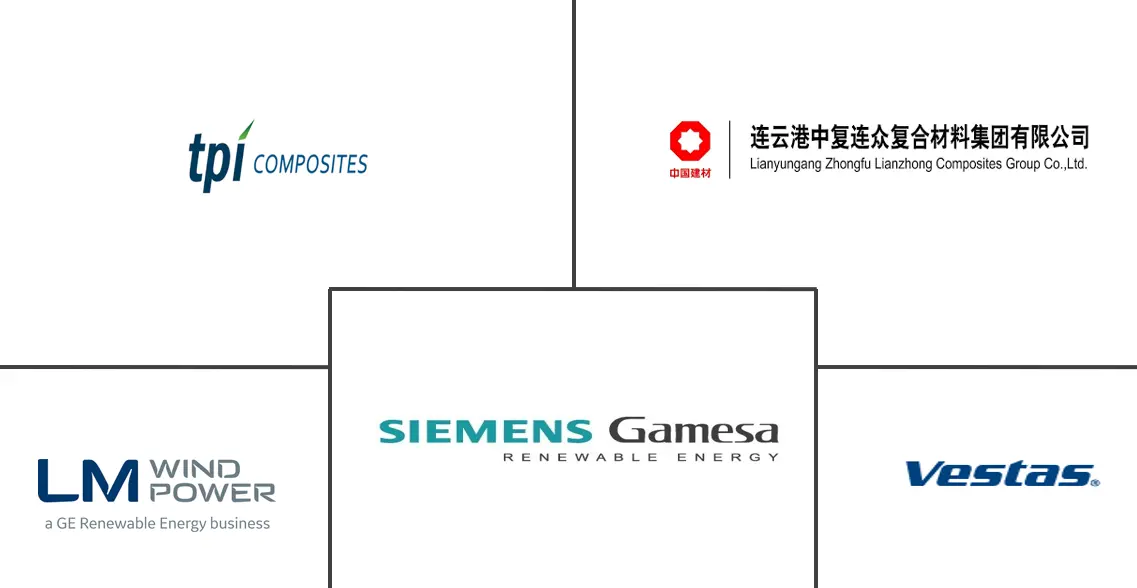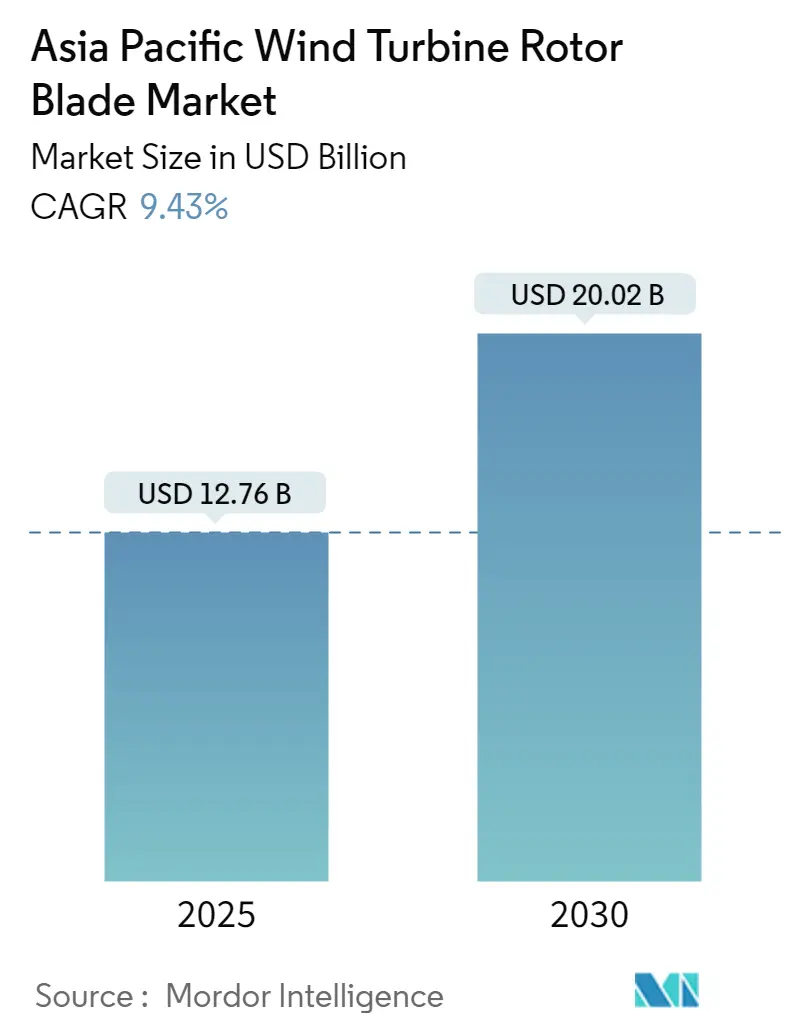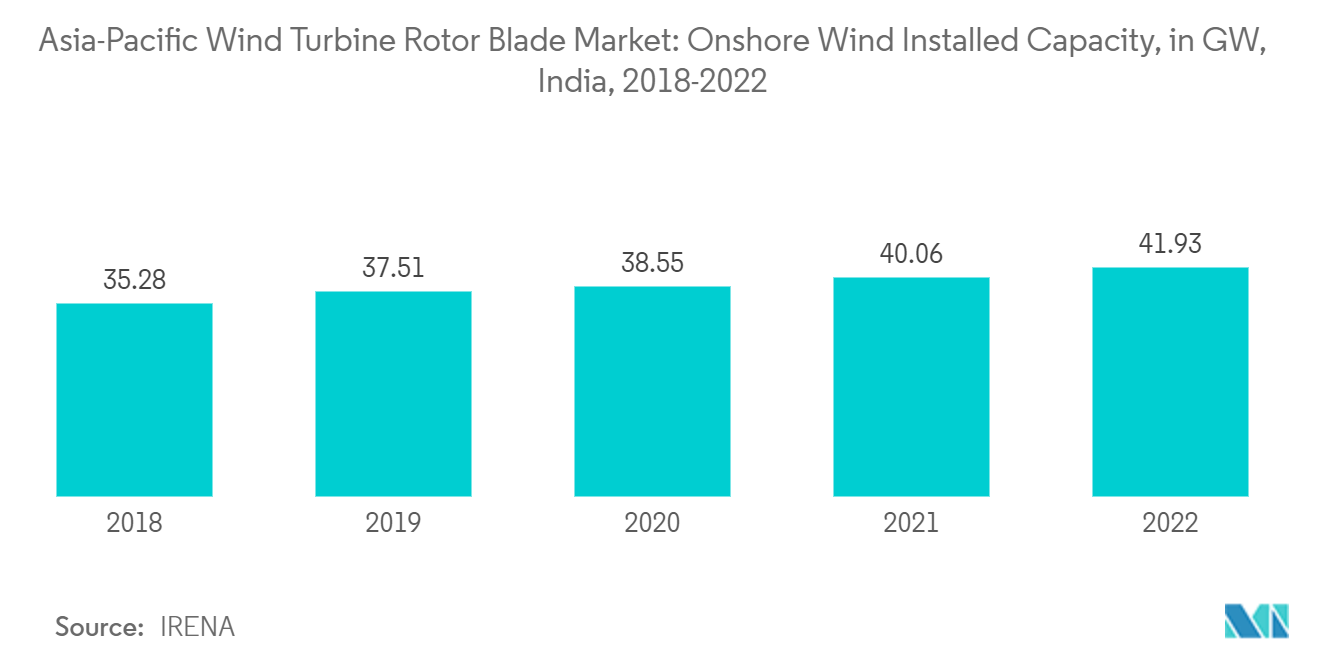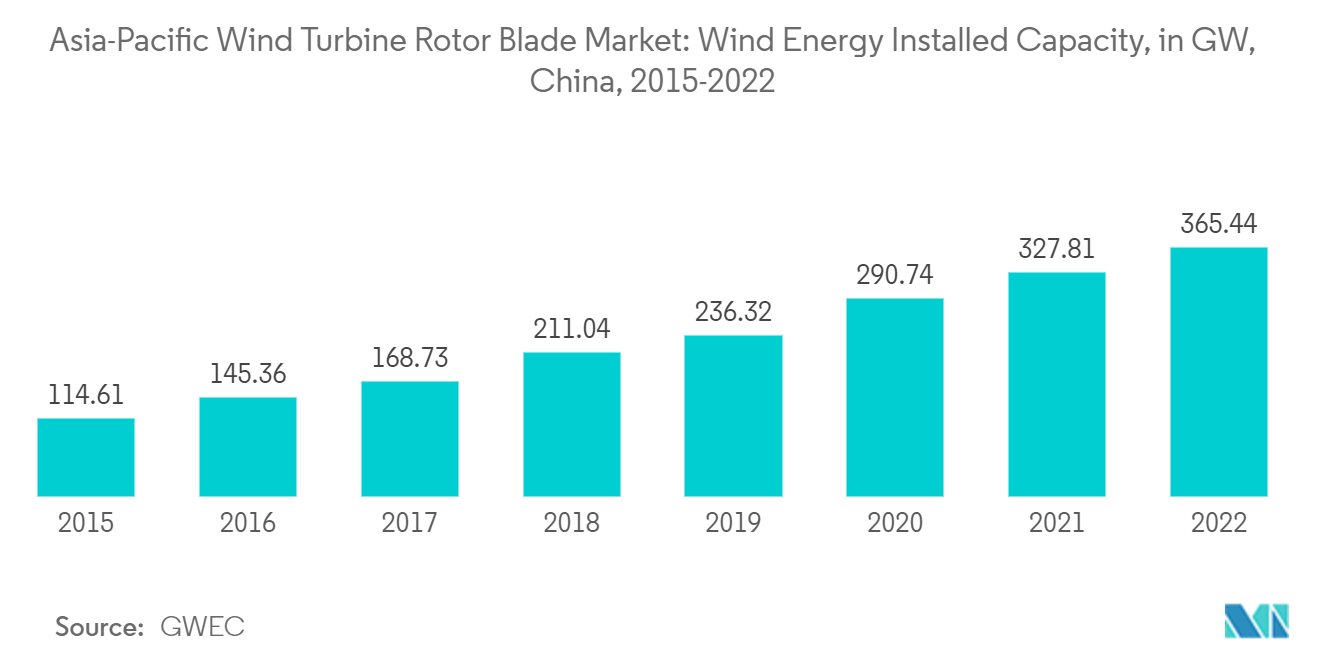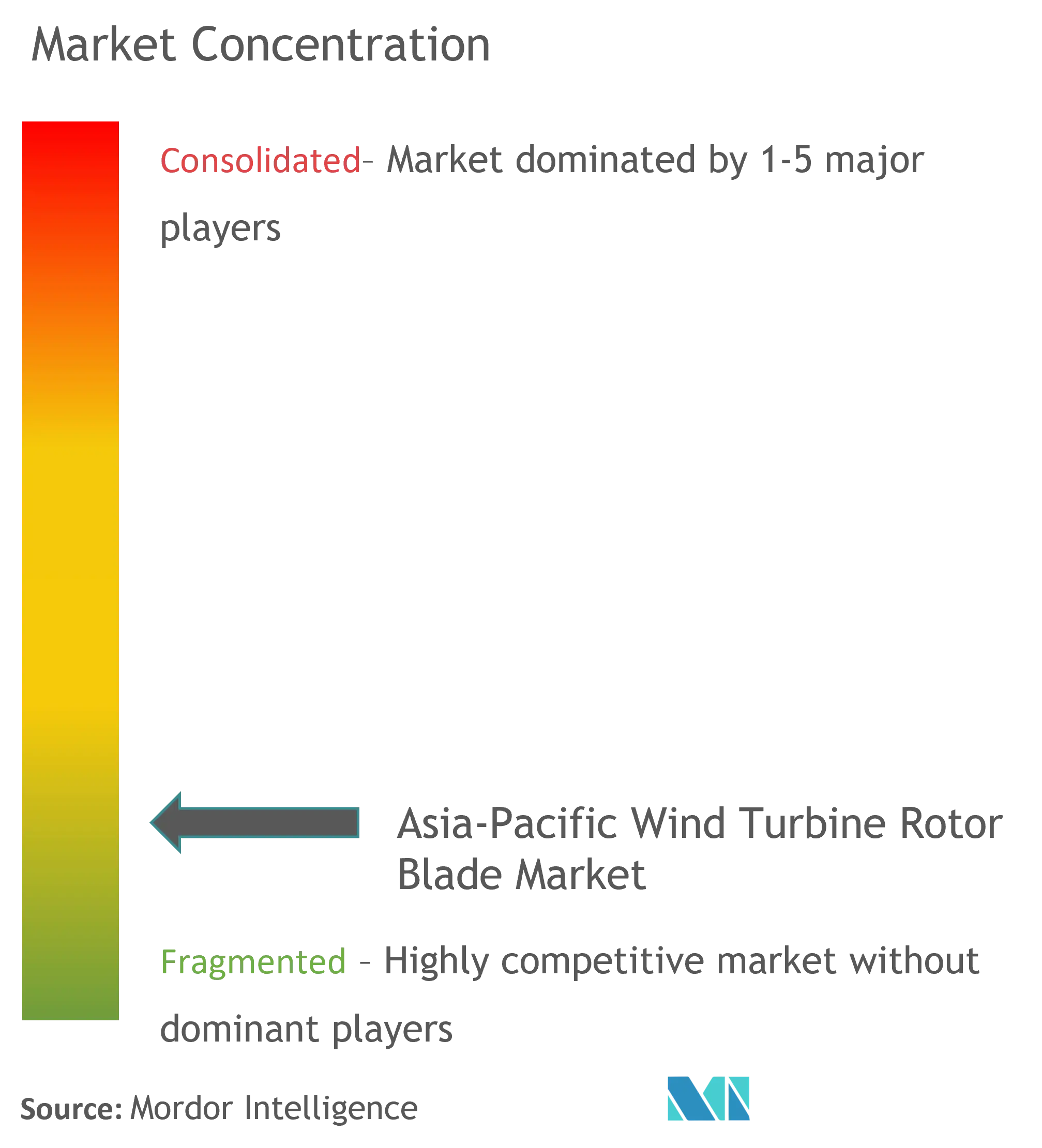Asia-Pacific Wind Turbine Rotor Blade Market Analysis
The Asia Pacific Wind Turbine Rotor Blade Market size is estimated at USD 12.76 billion in 2025, and is expected to reach USD 20.02 billion by 2030, at a CAGR of 9.43% during the forecast period (2025-2030).
Over the medium term, factors such as the declining cost of wind energy and increasing investments in the wind power sector are expected to drive the wind turbine rotor blade market in the Asia-Pacific region during the forecast period.
On the other hand, factors such as the associated high cost of transportation and cost competitiveness of alternate clean power sources like solar power, hydropower, etc., have the potential to hinder the market growth during the forecast period.
Nevertheless, the wind power industry has been in demand for cost-effective solutions, and a highly efficient product has the potential to change the dynamics of the industry. There were instances where old turbines were replaced, not because of the damage but due to the availability of more efficient blades in the market. Hence, technological developments present themselves as a good opportunity for the wind turbine rotor blade market soon.
China is expected to dominate the wind turbine rotor blade market in the Asia-Pacific region during the forecast period.
Asia-Pacific Wind Turbine Rotor Blade Market Trends
Onshore Segment to Dominate the Market
- The onshore wind energy power generation technology has evolved over the last five years to maximize electricity produced per megawatt capacity installed and to cover more sites with lower wind speeds. Besides this, in recent years, wind turbines have become larger with taller hub heights, broader diameters, and larger wind turbine blades.
- According to the Global Wind Energy Council (GWEC), the Asia-Pacific onshore wind market added 36.97 GW in 2022 and contributed 53.72% of the total global onshore wind installations in 2022.
- The growing investments in several major countries, such as China and India, are expected to drive the market demand during the forecast period. China and India are some of the fastest-growing economies in the world, and hence, they have registered significant growth in domestic power consumption.
- During COP26 in November 2021, the Prime Minister of India announced that India plans to reduce emission intensity by 45% or more by 2030, bringing it to levels below those of 2005, and announced 500 GW of non-fossil fuels energy capacity by 2030; 50% renewables in the energy mix by 2030.
- As of January 2022, non-fossil fuels represent 38.5% of overall power generation capacity. Wind currently accounts for 10.2% of this capacity. As part of its 2030 climate commitments, the Ministry of New and Renewable Energy (MNRE) estimates 140 GW of wind energy capacity is required.
- In October 2022, the NLC India Ltd., a Public Sector Undertaking (PSU) part of the Ministry of Coal, entered into a strategic collaboration agreement with the National Institute of Wind Energy (NIWE), an autonomous Research and Development institution under the Ministry of New and Renewable Energy (MNRE), for the development of onshore wind power projects in India.
- India holds the fourth-largest onshore wind power installed capacity globally as of 2022. These projects are majorly spread in the northern, southern, and western parts of the country. According to IRENA, India's total installed wind capacity was 41.93 GW, witnessing an increase of 4.64% compared to 40.06 GW in 2021.
- Moreover, according to the International Energy Agency, the Levelized cost of energy (LCOE) and global weighted average total CAPEX is likely to decrease from 76.1 USD/MWh and 1730.5 USD/MWh in 2016 to 48.2 USD/MWh and 1396.3 USD/MWh in 2021. In addition, the LCOE and average weighted CAPEX are expected to decrease in the forecast period to 44.6 USD/MWh and 1338.2 USD/MWh, respectively, by 2025.
- The onshore large wind turbine rotor blade market is expected to grow in the forecast period due to declining LCOE and reduced CAPEX, coupled with high energy demand through clean sources.
China to Dominate the Market
- China is the largest energy consumer and renewable energy market globally, and the country is rapidly expanding its renewable energy capacity to satiate its domestic energy demand. As the country has been suffering from air pollution caused primarily by fossil-fuel-fired power plant emissions, it has focused on expanding its renewable energy capacity to meet its growing energy demands while reducing overall emissions.
- As part of its 14th five-year plan (2021-2025), the country aims to supply 33% of national power consumption by 2025 and 18% of non-hydro renewables. The country aims to increase renewable energy generation to 3,300 TWh by 2030.
- In its latest updated Nationally Determined Contributions (NDC), China has committed to reaching peak emissions by 2030 and achieving carbon neutrality as part of its commitments under the Paris Agreement. In terms of energy targets, the country aims to cut C02 emissions per unit of GDP by more than 65% from 2005 levels and increase the total installed wind plus solar capacity to 1,200 GW.
- According to CarbonBrief, based on the rapid growth of the renewable energy industry in the country, it is estimated that China will reach its target of 1,200 GW of wind+solar deployment significantly ahead of its 2030 deadline. Such rapid growth in the installed wind energy capacity is due to the rising demand created due to environmental commitments, and the increasing domestic energy consumption is expected to drive the wind energy market during the forecast period.
- China’s provinces have set up individual targets for renewable energy projects as a part of national targets. The largest targets have been set up by the northwestern provinces of Inner Mongolia and Gansu to leverage the presence of large tracts of uninhabited desert lands. These two provinces plan to add a cumulative 190 GW of wind and solar projects by 2025, in addition to the 74 GW of installed capacity as of May 2022. These provinces are followed by Shaanxi, Hebei, and Shandong, which have planned to install 190 GW of new solar and wind capacity additions during 2021-2025.
- According to GWEC, in 2022, the total wind installed capacity increased by 11.5% compared to the previous year in China. The total wind energy installed capacity accounted for about 365.44 GW.
- Coastal provinces in China have been focused on developing new offshore wind capacity. Guangdong aims to install 18 GW of offshore capacity by 2025, while Fujian, Zhejiang, and Jiangsu aim to install 13.3GW, 6GW, and 9GW of offshore wind power projects by 2025, respectively.
- Shandong aims to add 35 GW of offshore wind power capacity by 2030 while starting the construction of 10 GW of projects and adding 5 GW to the grid by 2025. The island province of Hainan has been permitted by the National Energy Administration (NEA) to build 12.3 GW of offshore wind by 2025.
- Further, in December 2022, Chinese wind turbine manufacturer Mingyang Smart Energy produced the World’s Longest Anti-Typhoon Offshore Wind Turbine Blade for the MySE 16-260 offshore wind turbine, an elevated version of its 16 MW model, announced in 2021 with a 242-meter rotor diameter.
- Thus, the growing investment from state-owned companies and favorable government policies in wind energy generation are expected to drive the growth of the Chinese wind turbine rotor blade market during the forecast period.
Asia-Pacific Wind Turbine Rotor Blade Industry Overview
The Asia-Pacific wind turbine rotor blade market is moderately fragmented. Some of the major players in the market include Lianyungang Zhongfu Lianzhong Composites Group Co., Ltd., TPI Composites Inc., LM Wind Power (a GE Renewable Energy Business), Siemens Gamesa Renewable Energy S.A., and Vestas Wind Systems A/S, among others.
Asia-Pacific Wind Turbine Rotor Blade Market Leaders
-
TPI Composites Inc.
-
Lianyungang Zhongfu Lianzhong Composites Group Co., Ltd.
-
LM Wind Power (a GE Renewable Energy Business)
-
Siemens Gamesa Renewable Energy S.A.
-
Vestas Wind Systems A/S
- *Disclaimer: Major Players sorted in no particular order
Asia-Pacific Wind Turbine Rotor Blade Market News
- October 2022: China installed a 13.6 MW offshore wind turbine with a rotor blade diameter of 252 meters (827 feet), which is one of the largest in the world. The wind turbine was commissioned in China ahead of Beijing’s 20th Party Congress. The wind turbine can generate 63.5 million kWh per year, guaranteeing electricity supply to approximately 30,000 homes.
- March 2022: Hitachi Power Solutions will commence advanced services titled - Blade Total Service. It is expected to mitigate the risks of wind power facilities, including deterioration due to wear and tear of rotating blades, the stress imposed by violent winds during typhoons, and damage caused by lightning — by combining AI and other digital technologies with cutting-edge drone technology.
Asia-Pacific Wind Turbine Rotor Blade Industry Segmentation
Wind turbine rotor blades are the key components of wind turbines, as they are in direct contact with high-speed winds. Rotor blades convert wind's kinetic energy into rotational energy, which is later converted into electrical energy.
Asia-Pacific wind turbine rotor blade market is segmented by location of deployment, blade material, and geography. By location of deployment, the market is segmented into onshore and offshore. By blade material, the market is segmented into carbon fiber, glass fiber, and other blade materials. The report also covers the market size and forecasts for the wind turbine rotor blade market across major countries such as China, India, South Korea, and Japan.
For each segment, the market sizing and forecasts have been done based on revenue (USD).
Asia-Pacific Wind Turbine Rotor Blade Market Research FAQs
How big is the Asia Pacific Wind Turbine Rotor Blade Market?
The Asia Pacific Wind Turbine Rotor Blade Market size is expected to reach USD 12.76 billion in 2025 and grow at a CAGR of 9.43% to reach USD 20.02 billion by 2030.
What is the current Asia Pacific Wind Turbine Rotor Blade Market size?
In 2025, the Asia Pacific Wind Turbine Rotor Blade Market size is expected to reach USD 12.76 billion.
Who are the key players in Asia Pacific Wind Turbine Rotor Blade Market?
TPI Composites Inc., Lianyungang Zhongfu Lianzhong Composites Group Co., Ltd., LM Wind Power (a GE Renewable Energy Business), Siemens Gamesa Renewable Energy S.A. and Vestas Wind Systems A/S are the major companies operating in the Asia Pacific Wind Turbine Rotor Blade Market.
What years does this Asia Pacific Wind Turbine Rotor Blade Market cover, and what was the market size in 2024?
In 2024, the Asia Pacific Wind Turbine Rotor Blade Market size was estimated at USD 11.56 billion. The report covers the Asia Pacific Wind Turbine Rotor Blade Market historical market size for years: 2019, 2020, 2021, 2022, 2023 and 2024. The report also forecasts the Asia Pacific Wind Turbine Rotor Blade Market size for years: 2025, 2026, 2027, 2028, 2029 and 2030.
Our Best Selling Reports
Asia Pacific Wind Turbine Rotor Blade Industry Report
Statistics for the 2025 Asia Pacific Wind Turbine Rotor Blade market share, size and revenue growth rate, created by Mordor Intelligence™ Industry Reports. Asia Pacific Wind Turbine Rotor Blade analysis includes a market forecast outlook for 2025 to 2030 and historical overview. Get a sample of this industry analysis as a free report PDF download.

